The people of Oerth worship many gods, but after a major war, patterns of allegiance change. The focus in this section is on the gods of the central Flanaess; those that are exclusively Baklunish, for example, are too distant from the lives of most Flanaess folk to be considered here.
How Do Gods Look Upon Mortals?
The Gods of Oerth rarely intercede directly in the affairs of Oerth. They expect their servants to be their right (and left) hands in the world. Clerics, priests, paladins, and less exalted but still valued souls are the agents of Gods, however minor their deeds may be. The Gods have an implicit understanding that if one of them should act too directly, others will act in concert to oppose the meddler, for if all acted in such a manner, Oerth would be destroyed by the Gods.
This helps us understand why the demigod Iuz has been able to effect so much evil in the Flanaess. The Prime Material is his home plane, and therefore, he has a direct involvement in its affairs that other Gods do not. The servants must oppose Iuz, not the Gods themselves. One partial exception to this is St. Cuthbert of the Cudgel. Other Gods allow St. Cuthbert to act in limited ways to oppose Iuz. Why they do this, and how far St. Cuthbert is allowed to act, is a matter known only to the Gods.
In other respects, the Gods regard mortals as they do in almost all worlds. Mortals give reverence and their clerics and priests receive spells. The Gods watch with varying degrees of involvement. Greater Gods tend to have less involvement than Lesser Gods, because Greater Gods are more absorbed in the affairs of many worlds and transcendent events that are far beyond the affairs of mortals.
How Do Mortals Regard the Gods?
The gods and powers of the Flanaess are an often-confusing mix of deities from a handful of cultures, representing natural powers and human attributes, virtues (and vices), and mental and emotional states. In such an environment, the powers and attributes of some gods overlap. Certain others, generally Demi-Gods or Quasi-Deities, are once-mortal heroes (or villains) who have attained godlike powers. Most humans and demihumans worship one or two primary gods, but their worship is by no means exclusionist. The people of the Flanaess are pragmatists, and they willingly embrace as many gods as necessary to make their lives run more smoothly. While a farmer may worship the old Flan goddess Beory as the Oerth Mother, he may also offer money or tribute to the Suel god Phyton to bring fertility to his fields. More than this, whenever the farmer strays into non-agricultural endeavours, he may very well offer tribute to the god or gods appropriate to whatever he is doing. For instance, if he travels to the City of Greyhawk to sell his products in the market there, he may at different times during his trip offer tribute to Fharlanghn (god of roads), St. Cuthbert (god of honesty), Velnius (god of weather) and Zilchus (god of money). A lot of this "worship" will look perfunctory, like tossing coins into a fountain for luck, but it will be no less genuine for that. The people of the Flanaess feel their gods are real and can take concrete action on the material plane. This feeling isn’t changed by the fact that the most powerful gods rarely involve themselves directly with happenings on Oerth, St. Cuthbert being an occasional exception to this.
Gods of Humankind
Deities are divided into four groups: greater, intermediate, lesser, and demipowers. The basis of this broad distinction is as follows:
Greater Gods: These are distant Gods, far removed from most mortal affairs. Some may be held to be among the Creator Gods of the multiverse or of Oerth. They typically have many spheres of concern, or are absolute masters of just one sphere.
Intermediate Gods: While lacking the great creative force of Greater Gods, they are still very powerful and hold major sway over one or two spheres of concern. In some nations, they may be held as patron Gods, even above a Greater God.
Lesser Gods: A lesser power may serve greater ones as a messenger or aide, may be a cast-out or solitary power, or may hold sway over a very narrow sphere of concern. Some Lesser Gods may be declining from exalted status or may be ascending to greater force.
Demi-Gods: These are the least powerful and in many ways are similar to the Lesser Gods. Some may be mortals who have undergone divine ascension (Zagig and Mayaheine an being prime examples). Some may even be referred to as Hero Gods.
Details of Gods
Finally, note that not all of the Gods are detailed in the text below. All Greater and Intermediate Gods are covered, but Lesser Gods and Demi-Gods are too numerous to be included with the exception of Iuz, Mayaheine, and Zagyg, who have particular importance in the affairs of Oerth.
Greater Gods
Beory (Oerth Mother)
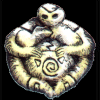
Beory commonly takes the form of a rotund, middle-aged, motherly woman with brown hair and weathered skin, and she is sometimes depicted as such. More often, though, the God of nature, rain, and the very Oerth itself is seen as a process rather than a being by learned folk, and she is considered very distant by common folk. The worldly doings of humans, demihumans, and their kindred are of almost no concern to Beory. Only events which affect the integrity of Oerth as an entity concern her. Beory has very few Priests; those who exist are druids (but they do not have the Charisma requirement of other druids).
Beory's Priests; AL N; RA green, brown, or gray plain robe
Priests of Beory are contemplative communers with nature, using their skills to avoid any change of the natural balance. They are conservative, cautious folk, loath to take incisive actions. Many are solitary, and the priesthood has little organization. Priests treat each other as superiors on the basis of wisdom and years, not as a result of formal titles or higher experience levels.
Boccob (The Uncaring)
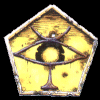
Boccob is the archmage of the Gods. Whether or not any serve or revere him seems of no importance to him. Throughout the Flanaess, seers and diviners entreat him for omens, sages revere him, and those seeking to create new magical items or spells often seek his aid. Boccob almost never leaves his own halls in the plane of Concordant Opposition, preferring to send his demigod servant Zagyg the Mad instead.
 Boccob is portrayed as an old man with bright, intense eyes, clad in garments of purple bearing shimmering golden runes. Within his halls, he has at least one example of every magical item ever devised and a copy of every alchemical formula ever scribbled down. He leans upon a staff of the magi, which also has the functions of a wand of conjuration.
Boccob is portrayed as an old man with bright, intense eyes, clad in garments of purple bearing shimmering golden runes. Within his halls, he has at least one example of every magical item ever devised and a copy of every alchemical formula ever scribbled down. He leans upon a staff of the magi, which also has the functions of a wand of conjuration.
All times and planes are open to Boccob. He manipulates the energies of the Positive and Negative Material planes as he wishes. He ever seeks to learn more of planar structures, the logic of magic, and long-lost lore. Services honoring him involve complex rituals, incense burning, and recitations from works honoring knowledge.
Boccob's Priests; AL N; RA purple robes with gold trim
Boccob's Priests are expected to be grave, serious folk devoted to the pursuit of knowledge. They must adventure to recover lost magical treasures, tomes of lore, and the like.
Incabulos

Incabulos is the God of evil sendings -- plague, sickness, drought, famine, nightmares. He is hideous in aspect, with skeletal hands, a deformed body, and a nightmarish visage. The black-cloaked rider of nightmare steeds has few worshipers in the Flanaess, but many seek to propitiate him with offerings. This is especially true in lands ravaged by famine, where disease has spread from unburied bodies on battlefields, and where chronic fear grips the common folk.
The scattered priests of this God have opportunities to sway hearts and minds in places of despair. Incabulos delights in being feared as much as in being revered; he is said to be able to use an almost irresistible sleep spell on victims, but he loves to sense their abject fear before he closes their eyes.
Those who worship this terrible God are intensely secretive. Even other evil priesthoods hate them. Incabulos's temples are always subterranean affairs in forsaken lands or desolate places. Services to the God feature weird humming and droning chants in near darkness, illuminated only by light from fat, smoky black candles. Followers celebrate multiple iniquities with their priests and pray for the arrival of more evils into the world.
Incabulos's Priests; AL any evil; RA black robe with orange and green detailing
The priesthood is highly secretive; many members are paranoid to the point of insanity. Fear and threats are used to maintain secrecy and the obedience of juniors. Priests of Incabulos revel in suffering, slow tortures, and inflicting disease and misfortunes.
Istus (Lady of Our Fate)

Istus, the Colorless and All-colored, is the God of future destinies and predestination. She has few true followers, but many call upon her in time of need or want when they fear the future. Istus receives many offerings in Baklunish lands and in places where people need good luck to sustain them (such as Free cities, under tyrannical rule in places such as Rauxes and the conquered Iron League states, and by the beleaguered Bandit Kingdom people).
Istus is depicted in one of three ways: as an old crone spinning the strands of the Web of Fate; as a noble and haughty woman; or as a cold, young maiden. Because Fate has been unkind to so many in the Flanaess, offerings of incense, candles, and the like are often ambivalent. Istus' priesthood is small, but often sought out by rulers and nobles for divinations.
Istus' Priests; AL N; RA gray or black robes, with web patterns for priests of higher level
Priests of Istus tend toward stoicism. They regard honesty as an absolute virtue. Many are cold, unfeeling folk, given the vagaries of Fate, although a few kinder souls may be found who feel that Fate has been uncommonly generous to them and wish to serve Istus in return. Divinations play a key role in the determination of the actions of these priests.
Nerull (The Reaper)
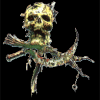
Foe of All Good, Hater of Life, Bringer of Darkness, Reaper of Flesh -- Nerull's formal titles bear eloquent witness to the horror of this cold, cruel, hateful God. Nerull is not a god who sees death as ease, release, or quiet passing; he brings bloody slaughter, and is the deity of many who seek evil for their enjoyment and gain.
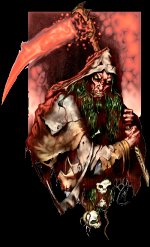 Nerull appears as a skeletal figure with a dull, rusty-red body and a skull-like head adorned with thick strands of blue-green "hair." His eyes, teeth, and nails are a putrid green. Known to fly at night, black-cloaked and cowled, his terrible reaper's staff-scythe strikes down all it sweeps through. Nerull is summoner of fiends, conjurer of darkness; his touch withers men and turns them to dust.
Nerull appears as a skeletal figure with a dull, rusty-red body and a skull-like head adorned with thick strands of blue-green "hair." His eyes, teeth, and nails are a putrid green. Known to fly at night, black-cloaked and cowled, his terrible reaper's staff-scythe strikes down all it sweeps through. Nerull is summoner of fiends, conjurer of darkness; his touch withers men and turns them to dust.
The worship of Nerull always occurs in complete darkness. The litany is ghastly, full of death and suffering. Bizarre and terrifying offerings are made on altars of rusty-colored stone. Nerull is known to have hidden temples in the lands of the former Great Kingdom and in other evil lands. A scarce few well-hidden, subterranean temples may befoul the foothills in more civilized lands.
Even in times of war and death, the common folk do not try to appease the Reaper. Any form of beseechment is thought to attract his fell green eyes to the supplicant, with life-ending results.
Nerull's Priests; AL any evil; RA rust-red or black garments
Nerull's priests are murderous, psychopathic, cold, cruel, and utterly evil. They are highly secretive, for obvious reasons. Priesthoods tend to be individual capsules without an overall hierarchy, except in evil lands.
Pelor
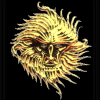
Pelor is the great Sun God, regarded as the Creator of much of what is good -- a God of strength, light, and healing. Pelor flies on a great ki-rin, summons flights of eagles, and casts down dark evils with bolts of brilliant sunlight.
 The nature of Pelor's reverence has changed subtly during and since the wars and is still changing. His old aspect of a peaceful, gentle god concerned for the suffering is eclipsed by his more martial aspect as a wrathful God who drives out the darkness of evil. This is parallel to the cult of Mayaheine, his servitor, a much more martial deity. As strengthener and healer, Pelor brings vitality to those beset by evil, and many warriors now turn to his faith.
The nature of Pelor's reverence has changed subtly during and since the wars and is still changing. His old aspect of a peaceful, gentle god concerned for the suffering is eclipsed by his more martial aspect as a wrathful God who drives out the darkness of evil. This is parallel to the cult of Mayaheine, his servitor, a much more martial deity. As strengthener and healer, Pelor brings vitality to those beset by evil, and many warriors now turn to his faith.
Services to Pelor involve hymn singing, communal prayer, and the dispensing of alms to the needy (and the collection of same from the well-to-do).
Pelor's Priests; AL any good; RA yellow robes
Pelor's priests have always worked for the poor and sick, bringing healing, food, and aid to them. Their reverence has not changed as swiftly as that of common folk. They remain quiet, kindly people for the most part, but with some steel as protection.
Rao
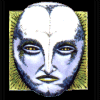
Rao is the serene, detached god of reason, intellect, and peace. The God does not act on the Prime Material directly, but he is known to have created several powerful magical artifacts which are highly potent against evil (notably the Crook of Rao), possibly with the aid of Boccob.
Rao is always depicted as a dark-skinned, white-haired old man with bright, dark brown eyes and long, slender hands; he is smiling and serene. Rao's faith is one that does not appeal much to common folk; he has always had more followers among rulers, diplomats, sages, scholars, and philosophers. Clearly, his church is not exactly overpopulated at present. Those who seek to find powerful magic to aid the cause of good make him valuable offerings and meditate on Rao's sacred texts. Services to Rao involve discussions of theology and group meditations.
Rao's Priests; AL LG; RA white robes
Rao's priests are mediators, and negotiators -- wise and quiet people. Most are male. Rao's High Patriarch in Greyhawk was instrumental in the diplomacy that ended the wars.
The priesthood is very studious, but one motto is "there is a time to think, and more rarely to act; but in that time, action is wisdom." These priests are not wholly pacifistic!
Intermediate Gods
Celestian (The Star Wanderer)
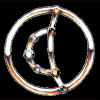
Celestian, the Star Wanderer, is said to be brother to Fharlanghn, the endless wanderer of the Prime Material. Celestian wanders the Astral, Ethereal and Inner planes, especially the Astral. He is depicted as a tall, lean man of middle years, ebony-skinned and dark of eye. His garments are inky black, but somewhere about him he has his symbol of seven "stars" (gems) which blaze with the colors of far suns. He has many unique spells unknown to other Gods (save perhaps Boccob). He affects meteors, comets, and similar heavenly bodies. As a form of Sky God, Celestian has influence over some aspects of light and weather.
 His worship is confined to a few sages, savants, and like souls, who often worship him privately or through travel to unknown lands and acquisition of knowledge.
His worship is confined to a few sages, savants, and like souls, who often worship him privately or through travel to unknown lands and acquisition of knowledge.
Celestian's Priests; AL any good or true Neutral; RA black robe covered with faint star patterns
This small priesthood is very studious and meditative, and also somewhat secretive and detached from everyday life. Acquisition of arcane lore and magical items that aid travel are important goals.
St. Cuthbert of the Cudgel
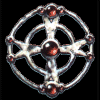
The Church of St. Cuthbert is of major importance in the Flanaess, with more converts to it every day, despite the zealous and stern nature of many of its priests.
St. Cuthbert is a God of dedication, zeal, and devotion to the causes of law (primarily) and good (secondarily). Common sense, truth, and forthrightness are his watchwords. He opposes chaos and evil sternly, with no backsliding or compromise permitted. This is a stern God who, with his priests, sees matters in black and white terms. For many folk living with the threat of Iuz to the north, this is a very credible world view. The great enmity between Iuz and St. Cuthbert adds to his popular appeal. St. Cuthbert's priests are also determined rivals of the priests of Pholtus.
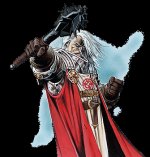 St. Cuthbert appears as a red-faced, barrel-chested man of nondescript appearance, even looking like a simple yokel at times. He is famous for wearing a crumpled hat and a starburst of rubies set in a platinum brooch.
St. Cuthbert appears as a red-faced, barrel-chested man of nondescript appearance, even looking like a simple yokel at times. He is famous for wearing a crumpled hat and a starburst of rubies set in a platinum brooch.
St. Cuthbert's Priests; AL LG, LN; RA crumpled hat (Chapeaux), dark green robes with starburst (Stars), or brown and russet garments (Billets)
Priests of St. Cuthbert are stout, stern folk who take no nonsense and speak their minds plainly. It's not that they won't suffer fools gladly -- they won't suffer them at all. Honesty and common sense are more prized than book learning and arcane knowledge. The faith is very practical, with attention to detail of everyday life and the concerns of common people. Since the war, military training and fitness are mandatory, much to the discomfiture of the more rotund members of the priesthood.
There are three orders of the priesthood: the Chapeaux, who wear crumpled hats and are zealots who seek converts to the faith; the Stars, who wear a form of the God's chest medallion and seek to retain doctrinal purity among the faithful; and the Billets, the most numerous, who use a cudgel as a holy symbol and serve as ministers to and protectors of the faithful (some 70% of the Billets are lawful good).
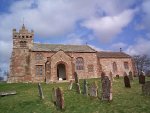
Services in honor of St. Cuthbert are often conducted in the small, wayside shrines and humble chapels he favors. Singing, prayer, recitation of edifying moral tales, and sharing of simple food (bread, milk, and gruel) are common.
Ehlonna (of the Forests)
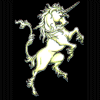
Ehlonna has many aspects: huntress, ranger, woman of the woods, protector of elves and half- elves, fertility goddess. She is concerned with all aspects of woodland life including the protection of good humans and demihumans, especially (half) elves. She is depicted as a young, lovely female (human, elven, or half-elven, choosing which form she wills). In any form, she is recognizable by her startlingly deep blue-violet eyes and a very clear and fair complexion.
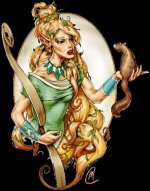 Ehlonna is kind and benevolent, but sternly opposes evil humanoids and marauders who despoil woodlands. Her faith is strong among the Highfolk (where she is the most widely revered God), wood elves in general (especially in UIek, Celene, and the Suss/Welkwood/Gnarley forests), and in many scattered woodland communities. Services of worship include simple repasts (often of uncooked, "natural" foods gathered in the woodlands), drinking of wine, and the playing of flutes, pipes, and lyres. If a bard is at hand to entertain, so much the better.
Ehlonna is kind and benevolent, but sternly opposes evil humanoids and marauders who despoil woodlands. Her faith is strong among the Highfolk (where she is the most widely revered God), wood elves in general (especially in UIek, Celene, and the Suss/Welkwood/Gnarley forests), and in many scattered woodland communities. Services of worship include simple repasts (often of uncooked, "natural" foods gathered in the woodlands), drinking of wine, and the playing of flutes, pipes, and lyres. If a bard is at hand to entertain, so much the better.
Ehlonna's Priests; AL any good; RA pale green robes
Ehlonna's priests are fine woodsmen, with males and females equally represented and regarded within loose hierarchies. They are skilled hunters and woodland spies, and work to protect woodlands against evil.
Erythnul (The Many)
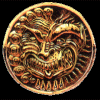
Erythnul is the God of capricious malice, envy, hatred, and fearful panic. His worshipers include many humanoids, for Erythnul smiles on fickle, wicked deeds from them as much as from humans. Erythnul delights in the fear, rout, and terror of battlefields, and is himself depicted terrifyingly as a seven-foot brute, hairy and red-faced, with mad, staring green eyes. He can change from human to gnoll to bugbear to ogre to troll at will, and he carries a huge stone-headed mace. He is a summoner of creatures of battle, and if wounded, monsters spring from his blood.
 Erythnul is worshipped by evil, embittered, cruel creatures. Services to him include playing of shrill and discordant reed instruments, the banging of gongs, and ritual drumming. Major rites include burnt offerings. Humanoids of the Bone March and the Pomarj include many devotees of Erythnul, as do evilly-inclined bands of bandits and brigands around the Flanaess.
Erythnul is worshipped by evil, embittered, cruel creatures. Services to him include playing of shrill and discordant reed instruments, the banging of gongs, and ritual drumming. Major rites include burnt offerings. Humanoids of the Bone March and the Pomarj include many devotees of Erythnul, as do evilly-inclined bands of bandits and brigands around the Flanaess.
Erythnul's Priests; AL CE, NE; RA rust colored garments, blood-stained robes for ceremonies
Erythnul's priests include many gnolls, bugbears, and ogres. There is no fixed hierarchy, and a junior may demonstrate his fitness to boss his fellows by dispatching an older priest (envy is a virtue, after all). The priests are bullies -- hateful backstabbers and wanton killers -- acting on evil impulse and reveling in bloodshed.
Fharlanghn (The Dweller on the Horizon)
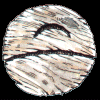
Fharlanghn is the God of travel, distance, roads, and horizons. His feet are restless ever to wander the many worlds of the Prime Material, his eyes ever on the horizon.
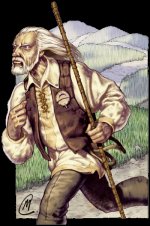 Fharlanghn is portrayed as a middle-aged man with weathered and wrinkled brown skin and bright green eyes. He is plain-clothed and unencumbered, carrying only an iron-shod staff and a disc with a curved surface representing the horizon. The disc is made of many woods and is inlaid with jade and turquoise. A bright golden sun-disc is set into the object. Fharlanghn is known to use the disc for divinations.
Fharlanghn is portrayed as a middle-aged man with weathered and wrinkled brown skin and bright green eyes. He is plain-clothed and unencumbered, carrying only an iron-shod staff and a disc with a curved surface representing the horizon. The disc is made of many woods and is inlaid with jade and turquoise. A bright golden sun-disc is set into the object. Fharlanghn is known to use the disc for divinations.
Since travel is perilous in much of the Flanaess, more folk now turn to Fharlanghn with offerings, if not actual worship. His priesthood is small, a wandering fellowship. Services to the God are always outdoors, preferably under a sunny sky, and involve telling of traveler's tales, sharing stories of good people, and bestowing blessings on the worshipers while drinking ale and sharing simple food.
Fharlanghn Priests; AL NG, N; RA brown or green robes, very plain and ordinary
This is a small, wandering priesthood, ever eager to set foot on the road. The priests are practical folk, yet trusting and almost naive in their faith. Collecting tales of the toad, recording them, or drawing scenes from far lands are the delight of these priests. They are kindly people who always offer generosity to other travelers. The priesthood does include some urban members, but these are often elderly priests whose traveling days are done.
Heironeous (The Invincible)
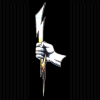
Heironeous is the champion of rightful combat and chivalrous deeds. He is the patron God of those who fight for honor, justice, and the fair, good order of things. Clad in chain mail and hefting a great magical battle axe, Heironeous is portrayed as a youthful, tall man with coppery skin, auburn hair, and amber eyes, and is unsurpassingly handsome. He is a "beloved of the Gods"; his skin is said to be magically enchanted to break most weapons striking him, and he has many natural gifts given him by the Gods of lawful good.
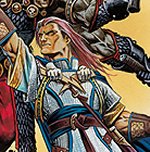 Heironeous is typically a God revered by officers, leaders, and paladins rather than the common warrior, but this is changing. Heironeous is strong as a fighter and as a protector, and this duality attracts many worshipers. He is widely revered throughout the nonevil lands of the Flanaess.
Heironeous is typically a God revered by officers, leaders, and paladins rather than the common warrior, but this is changing. Heironeous is strong as a fighter and as a protector, and this duality attracts many worshipers. He is widely revered throughout the nonevil lands of the Flanaess.
Services to Heironeous include triumphal singing of battle hymns, offerings made to a copper statue of the God, (such statues adorn most of his finely decorated temples), and sharing of strengthening foods -- meat, full-bodied red wine (in moderation) and spiced, stewed kara-fruit.
Heironeous' Priests; AL LG; RA dark blue robes with silver trim (senior priests have more ornate silvering)
This is a warlike priesthood that counts many elven and half-elven fighter/clerics and many human priests who have attained several levels of experience as warriors before becoming priests. The priesthood has a military organization and maintains excellent armories and systems of communication. Older priests are revered for their strategic skills and as teachers. Opposition of priests of the hated Hextor is mandatory. Possession of magical chain mail and/or a battle axe brings great kudos within the cult.
Hextor
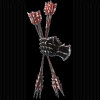
Hextor, Scourge of Battle, Champion of Evil, is patron God of many evil warriors and a few humanoids. Hextor is portrayed as a six-armed, gray-skinned, gray-haired man with fiery red eyes, although he can assume a more handsome form. As befits a many-armed warrior God, he employs a variety of weapons, as do his priests.
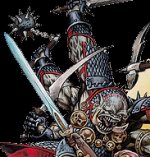 Hextor is worshipped by evil warriors and assassins, mercenaries and murderers. His following has always been strongest within the lands of the Great Kingdom, where his priests hold sway in many residual fiefs and attend upon Ivid. Services to him include discordant music from wind instruments, shouting and screaming, and the striking of iron weapons. The greatest temples are built on sites of great battles or bloodshed.
Hextor is worshipped by evil warriors and assassins, mercenaries and murderers. His following has always been strongest within the lands of the Great Kingdom, where his priests hold sway in many residual fiefs and attend upon Ivid. Services to him include discordant music from wind instruments, shouting and screaming, and the striking of iron weapons. The greatest temples are built on sites of great battles or bloodshed.
Hextor's Priests; AL LE, NE; RA black robes adorned with white skulls or gray visages
These priests are skilled combatants and assassins, cruel and violent, bereft of subtlety while still being cunning and wily. The priestly hierarchy is rigid, dominated by strength and cruelty.
Crom (Lord of the Mount)
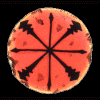
Crom is a Suloise God appearing as a mighty, sword-wielding barbarian with powerful weaponry and armor. He is thus a God of combat and strength. Not widely revered, Crom has a following among the barbarian peoples, parts of Ulek, and among Suel folk in Aerdi. Despite his power as a god of struggle and strife, few turn to him as he has no protective aspect. Crom answers no prayers!
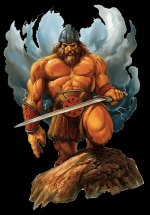 Crom's Priests; AL CG, CN; RA red with white trappings
Crom's Priests; AL CG, CN; RA red with white trappings
Priests must be strong, well armed and trained, and able to maintain fitness and readiness for combat. This is a warrior priesthood, but it does not have aims of conquest, dominion, or strategic goals, since the God is chaotic. Possession of a magical edged weapon is a major goal for many. If nonweapon proficiencies are used, those such as swimming, running, jumping, and blind-fighting are allowed to this priesthood.
Lendor

This very old Suel God is referred to as "Prince of Time and Tedium," which explains why his reverence is almost extinct on Oerth. Said to be the Creator of the other Suel Gods, Lendor is distant, aloof, and preoccupied with the unfolding of events through time in all the multiverse.
Lendor's handful of worshipers are sages, old men, and others distant from everyday concerns. Services to this God involve interminable recitations, officiated by elderly priests who find it difficult to recruit others to their faith.
Lendor's Priests; AL LN; RA silver robes adorned with a black circle containing a crescent moon surrounded by 14 stars
The priesthood of Lendor is elderly, rigid, and uncreative. This priesthood is preoccupied with ritual, formalities, and unswerving devotion to lawful neutrality.
Obad-Hai (The Shalm)
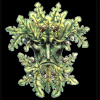
Obad-Hai is an ancient Flan nature deity, whose worship has spread throughout the Flanaess. He is a lover of wilderness and nature, a patron of druids, and a friend to those who live in harmony with their natural surroundings. Because of his neutrality, there is enmity between him and Ehlonna of the Forests. He is most revered by druids who live in very wild places: those of the barbarians and other underpopulated lands.
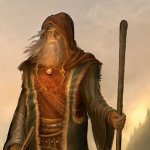 Obad-Hai is represented as a lean, weathered man of considerable age, as if a hermit, pilgrim, or simple rustic. He can also appear as a gnome, dwarf, or halfling, and has his worshipers among those folk; he is also represented in the form of woodland animals of diverse kind. Shrines of Obad-Hai are usually wooden structures found in rustic settings. Services to him involve the consecration of living flowers, earth, water, and fire.
Obad-Hai is represented as a lean, weathered man of considerable age, as if a hermit, pilgrim, or simple rustic. He can also appear as a gnome, dwarf, or halfling, and has his worshipers among those folk; he is also represented in the form of woodland animals of diverse kind. Shrines of Obad-Hai are usually wooden structures found in rustic settings. Services to him involve the consecration of living flowers, earth, water, and fire.
Obad-Hai's Priests; AL N; RA simple russet garments
Obad-Hai's priests are treated as druids. The priesthood is non-hierarchical, treating each other as equals, irrespective of level. Age is a basis for deferment among them.
Olidammara
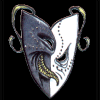
Olidammara, the Laughing Rogue, is patron God to many thieves and bards. He is portrayed as a wandering minstrel or vagabond, a slim man with chestnut hair and rakish beard, olive-tinted skin, sparkling emerald eyes, and green and gold clothing. Delighting in wine, women, and song, Olidammara is the eternal prankster and chaotic spirit. He is a master of disguise.
 Olidammara's cult is steady within the Flanaess; in the darkest times, people must have some form of diversion lest they succumb to despair, and while they may not worship this God, they are glad enough if one of his priests or clerics is on hand to bring laughter and song. His temples are not commonly found (neither is his priesthood), but services to him are light-hearted affairs, including much singing, chanting, music, feasting, and ample consumption of beers, ales, and wines.
Olidammara's cult is steady within the Flanaess; in the darkest times, people must have some form of diversion lest they succumb to despair, and while they may not worship this God, they are glad enough if one of his priests or clerics is on hand to bring laughter and song. His temples are not commonly found (neither is his priesthood), but services to him are light-hearted affairs, including much singing, chanting, music, feasting, and ample consumption of beers, ales, and wines.
Olidammara's. Priests; AL CN; RA robes of green, brown, green and brown, or green and black
This priesthood contains both urban priests, found mostly in large cities, and wandering minstrel priests. These priests are not popular with lawfully-aligned priests of other Gods because of their general irreverence and fondness for upsetting established order. Olidammara's priests are required to sing or play a musical instrument.
Pholtus of the Blinding Light
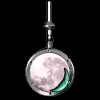
Pholtus is a God with a fixed resolve to show all creatures the One True Path. This "Path" allows no deviation, but gives absolute assurance of rightness. Pholtus is the sternest guardian of unbending Law, and a defender of rightful and just order. He is portrayed as a tall, slender man, clad in a white silk robe, with pale skin, flowing white hair, and bright blue eyes that shine with the inner fire of devotion. He holds an ivory staff shod with silver and topped with an electrum disc, the Silvery Sun.
Worshipers of Pholtus are often rigid, unbending folk, and many have taken refuge in a religion of such certainty after the war. The Theocracy of the Pale worships Pholtus in his Lawful Neutral aspect. There is friction between that nation and its priesthood and those who accept the image of Pholtus as a champion of good. Many paladins and some warriors revere Pholtus.
Services to Pholtus take place in consecrated buildings decorated in white. Photus's church is called The Powerhouse Church of the Presumptuous Assumption of the Blinding Light of Faith and includes candle-burning and long sermons. The anthem of the worshipers is "O Blinding Light."
O' Blinding Light,
O' Light that Blinds,
I cannot see,
Look out for me! 
Pholtus's Priests; AL LG, LN (LN only in the Theocracy); RA white robes (Glimmering) with silver (Gleaming) or gold (Shining)
This priesthood is most active in urban districts. Priests continually seek to reveal the light of Pholtus to unbelievers. They brook no arguments, of course, and are generally disliked by most other priesthoods (especially those of the rival St. Cuthbert, and chaotic priests). The priesthood is well organized and strongly hierarchical; Lower level priests are of the Glimmering Order, those of medium level are of the Gleaming Order, those of the higher levels are of the Shining Order.
Priests of Pholtus are expected to observe stringent standards of morality and righteousness.
Procan
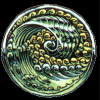
Procan is the God of the seas and oceans, weather, and navigation. He is portrayed as a muscular, large man with blue-green skin and hair and golden eyes, armed with a great spear from which hangs fronds of seaweed. Procan is stormy and impulsive, prone to fits of temper, and is ever greedy for treasure, hoarding that which falls to the sea bed and jealous of the pearls and wonders of his own domain.
Fisherfolk and sailors seek to placate Procan. Small shrines to the God are found in ports of any size. He has few worshipers, concentrated among those who live most of their lives at sea. Some sentient aquatic creatures worship Procan.
Services to Procan are always close to or upon the sea. They include offerings of gold or pearls cast into the waters, eating of fish and bread, and prayers for safe sea travel.
Procan's Priests; AL CN; RA blue or green robes
This priesthood is a simple, everyday sort, attentive to the lives of those who must earn their living on the seas. They eschew formal ritual and dress simply. It is considered good fortune by seamen to have a priest of Procan aboard ship!
Ralishaz (The Unlooked For)
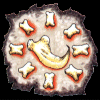
Ralishaz is the God of chance, ill-luck, and unexpected misfortunes. He is also the patron God of gamblers and those who take unusual risks. Most often, Ralishaz will not reward the latter, but if he does, the rewards may be great indeed.
Ralishaz is portrayed in a variety of forms. He may appear as an idiot or dolt, a hideously wrinkled old man, a scabby beggar, or even as a beautiful maid. He employs only wooden weapons, usually a staff. He is a formidable purveyor of curses and magical aging, and has a gaze that can cause sleep.
Victims of misfortune may try to placate Ralishaz; gamblers invoke him; those in peril beseech him; those planning speculative, high-risk adventures will make offerings to him. His cult has grown somewhat during and after the war. Services to Ralishaz include playing semi-random note sequences on musical instruments, babbling paeans, the casting of augury spells, and wild interplays of light and darkness, heat and light, noise and quiet.
Ralishaz's Priests; AL CN, CE; RA robes of mixed, clashing colors
Priests of this God are said to suffer misfortunes only rarely, but when they do, they are grave indeed. The priests tend to alternate between stoicism and wild endeavor. Casting augury spells plays a great role in their lives. They are often mean-minded or deceitful folk.
Tharizdun (Dark God)
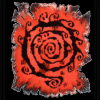
What manner of God Tharizdun is is unknown, although his name is associated with loss of strength and sanity, exhaustion and cold, fatigue, mind-bending illusions, depression, catatonia, and paralysis. Legend says that Tharizdun is banished and imprisoned in some unknown demi-plane, but there are those who strive to bring their old master forth. What manner of madmen, or which creatures, served him aeons ago is unknown. The Scarlet Brotherhood is said to revere Tharizdun and to seek his release through the use of a mighty artifact of evil.
Worship of Tharizdun takes place in unknown subterranean temples of chill, darkness, and insanity. Such places are highly secret, and many are lost and ruined. Litanies of this God are hideous in the extreme. Most folk feel that the less they know about the Dark God, the better they like it. Even mention of his dread name is held to be a danger.
Tharizdun's Priests; AL any evil; RA black robes
The sole duty of this priesthood is to free Tharizdun from his prison. They sacrifice all to this end. The extent and location of the priesthood is unknown.
Trithereon (The Summoner)
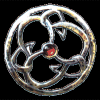
Trithereon is the God of individuality and the right to self-protection. His symbol, a pursuit rune, indicates the need to strive for liberty and to seek to bring an end to those bent on abridging life or freedom.
Trithereon is depicted as a tall, well-built young man with red-gold hair and gray eyes. He wears pale blue garb with golden chain mail, and carries a broad-bladed spear, a broadsword, and a scepter. It is said that Trithereon is able to summon many creatures to aid him in battle.
Trithereon's aspect as a God of protection and revenge on wrongs appeals greatly to many people. In borderlands such as the Highfolk, Sunndi, and northern Furyondy, and especially to those seeking to regain lost homes (Geoff folk, Sterish, Ulek, Shield Land exiles), he has a burgeoning following. Even in a well-ordered land such as the Yeomanry, this chaotic, freedom-fighting deity finds many passionate converts. This is the strongest-growing cult in the Flanaess, together with that of St. Cuthbert. Services to Trithereon include ceremonial flames, bell-ringing, displays of weaponry, and the triumphal procession of new converts to the faith.
Trithereon's Priests; AL CG; RA blue robes
In rural areas, the priests are spies and border skirmishers (where appropriate), and they work with woodsmen and demihumans to keep vigilant watch against despots and evil humanoids. In urban areas, the priesthood gives training in self-protection and weapon use, regularly practices battle tactics, and recruits rangers and thieves to teach priests the skills of covert conflict.
Ulaa
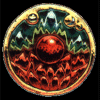
Ulaa is the patron God of miners, hillmen, mountaineers, and quarrymen. She has some following among the demihumans engaged in such tasks, and is often portrayed as a dwarf or gnome. In her more typical human portrayal, she is shown as a plain-faced, strong, determined woman with skin as hard as stone, clad in chain mail and hefting a military pick and great warhammer.
Ulaa's following is concentrated in hilly rural lands such as the Kron Hills and Flinty Hills. Nearly all her temples are underground. Services include displays of gemstones and fine minerals, rhythmic hammering on stone, and chanted hymns.
Ulaa's Priests; AL LG, LN; RA brown, green, or brown-green robes
This priesthood is strongly community based. The priests watch over the maintenance of mines and quarries, use spells to ensure the safety of those who work therein, and work with priests of other races. A special note regarding their granted powers: like rangers, priests must choose a racial enemy, typically a hill-dwelling humanoid or giant race (ogres, gnolls, orcs, etc.).
Wee Jas

Wee Jas is the Suloise God of magic and death. She is portrayed as an attractive, well-dressed young woman, but her necklace --an ivory skull set against a ring of fine fire rubies --gives away her nature. Wee Jas is primarily lawful, but she inclines toward evil through her preoccupation with power.
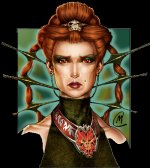 Wee Jas is not widely revered even among Suel folk, although it is said that some of the Scarlet Brotherhood look to her magical powers with devotion. However, funeral rites among the Suel, even the barbarians, usually involve a small offering to her to protect the soul of the departed. She is a protector of the dead, and her priests are only rarely allowed to command undead creatures, having to commune with Wee Jas to see if this is acceptable to her.
Wee Jas is not widely revered even among Suel folk, although it is said that some of the Scarlet Brotherhood look to her magical powers with devotion. However, funeral rites among the Suel, even the barbarians, usually involve a small offering to her to protect the soul of the departed. She is a protector of the dead, and her priests are only rarely allowed to command undead creatures, having to commune with Wee Jas to see if this is acceptable to her.
Services to Wee Jas include the reverent flattery of fine icons of her (she is a vain God), offerings of finery and gems, and magical fires.
Wee Jas's Priests; AL LN, LE; RA black (evil) or gray (neutral) robes
Wee Jas's priests are officiators at funerals, maintainers of graveyards, and ardent students of magic and arcane lore. The priesthood has rigid ordering and demands absolute obedience from its juniors.
Xan-Yae

Xan-Yae is the goddess of Twilight, Shadows, and Stealth, her teachings include the Mental and Physical Mastery of Mind over Matter. Xan Yae appears always in human form, but of either sex and of any age. In any guise, she is slender and graceful, but only in her true form is she recognizable as the Lady of Perfection Xan Yae usually is dressed in cloth of dove gray, dusty rose, or golden orange, regardless of her guise.
Xan Yae is one of the rare deities of the Baklunish who has attained a measure of service across the Flanaess. The goddess is sometimes known as "The Perfect Mistress" by those who serve her through the pursuit of martial arts. She is the epitome of grace, speed, and perfection with respect to such discipline.
Those individuals who seek mastery of their mind and body, as well as those who favor twilight, are prone to serve Xan Yae. Thus, her followers include monks, thieves, and less savory sorts, as well as young lovers and those of cautious nature.
Xan Yae's Priests; AL N; RA Gray over sunset-hued robes
Places of worship of Xan Yae are typically in secluded settings. Those found in urban centers will be large, but constructed so as to be unnoticeable as a monastery, temple, or whatever. Services include dance-like exercises, meditation, reading, chanting, and prayer. The light always is shadowy and dim, and breezes tinkle chimes and bells so as to provide background "music."
Zilchus
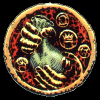
Zilchus is a God who oversees affairs of money and business, but is also a temporal power concerned with prestige and influence. Zilchus is a God revered by those who are fair, scrupulous in their dealings, and honest; shady merchants do not look to this God.
Zilchus is portrayed as a middle-aged, smiling man with thick curly brown hair and brown eyes, tanned skin, and a dignified demeanor. He is richly dressed, but without ostentation or finery. He carries a purse full of gold, and also a flail with which to chastise the dishonest.
Zilchus's faith has always been widespread throughout the central Flanaess and remains so, for when trade is brisk, honest dealings are more important than ever. Zilchus's aspect as a God of prestige and influence is somewhat lessened by the rise of more martial deities, but his priests are still listened to by most rulers because of their honesty and diplomatic skills.
Zilchus remains primarily a God revered by the well-to-do and noble, rather than the common folk. Services to Zilchus involve incense burning, small offerings of goods, sermons, and homilies.
Zilchus's Priests; AL LN; RA white or gray robes with silver trim
Many of the priests are themselves merchants, nobles, or in a position of temporal power; this is regarded as a sign of one's worth. Priests strive hard to mediation and diplomacy, and tend to get on well with priests of Rao (who gently chide them for their worldliness).
Demi-Gods
Iuz (The Old)
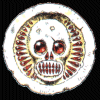
Iuz can appear as a 7'-tall, red-skinned, steely-fingered fiend, or as a shriveled old man five feet in height (he can take many forms; these are simply his habitual ones).
Iuz has many magical items looted from the Hierarchs, Shield Lands, and elsewhere. His throne has many magical properties, his palace holds a permanent gate to the Abyss, and so on. Iuz's resources are great indeed.
Iuz's Priests; AL CE, NE; RA black or bloodstained white robes
This priesthood is cruel, barbaric, and sadistic. The priests revel in cruelty and inflicting fear on those weaker than themselves, and they forever try to outdo each other. The more exalted members of their ranks who become part of the Boneheart (three echelons of six members, though not all are priests) keep quiet in Iuz's presence unless commanded to speak. Senior priests are now token rulers of many provinces of Iuz's expanded domain, although Iuz holds them responsible for events therein, so this is a mixed blessing.
Trophy hunting is important to Iuz's priests, and a fine array of stuffed and mounted heads brings approval and esteem. Possession of a true work of art (e.g., an embalmed and stuffed paladin) gains considerable kudos for the owner.
Mayaheine
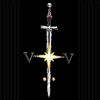
The cult of Mayaheine is one considerably on the increase in beleaguered, nonevil Flanaess lands, for Mayaheine is a demipower of protection and survival. Mayaheine rose from mortal ranks as an epic hero, a paladin of Pelor. She does not originate from Oerth and has traveled, with Pelor's aid, from some unknown alternate world in the Prime Material. Flanaess folk see this act as potential salvation and revere her for coming to aid them (Pelor's cult has improved its standing, too).
Mayaheine is portrayed as a strikingly tall (6' 4") woman of some 30 years of age, tanned of skin, with blue eyes and auburn-gold hair. She wears silvered plate mail and hefts a magical bastard sword. She is a fine warrior, but above all, she is a protector. Tales of her always involve her seeking out protective magical items and giving them to others in need, and fighting to defend beleaguered communities. Mayaheine strives to defend the poor and downtrodden. She is a defender-on-the-ramparts figure, armed with a deadly longbow said to fire almost to the horizon. Her magical shield is said to be capable of melding into stone and protecting city walls from fire, frost, and magical assault.
Services to Mayaheine include hymn singing with the congregation linking arms, consecration of weapons, armor, and shields, and collection of alms for the needy. Her priests are few, since the cult is young.
Mayaheine's Priests; AL LG; RA white robes with gold trim
This priesthood is still organizing itself, often under the auspices of priests of Pelor, to whom Mayaheine's priests are most respectful. The priests are often young, and they train for combat using self-defense exercises. Traveling priests aid border communities in constructing defenses.
Zagyg (The Mad)

Zagyg is the Mad Arch-mage, servitor of Boccob, the demipower of humor, eccentricity, and occult studies. He is mad inasmuch as none but his master seem to be able to fathom his reasoning and sense of humor.
Zagyg has no priests and very few worshipers.
Zagyg is rarely portrayed, since he can appear in any guise he wishes, but the few portraits that exist show a balding, white-haired, portly fellow with a wide smile and eyes inscrutably closed. This depiction bears a striking similarity to Zagig Yragerne, the lunatic of the Free City of Greyhawk who initiated the construction of its infamous Castle. Sages usually consider the two to be one and the same. Whether the demipower took mortal form, or the mortal became a demigod, is unknown.
Zagyg receives small offerings and homages from time to time, from sages and scholars studying difficult and arcane areas of lore. Whether Zagyg takes any notice of this is unknown.
Relations Between Gods

In the entries above, some mention has been made of relations between Gods and their priests (such as the enmity between Pholtus and St. Cuthbert). The most important allegiances and oppositions obviously have great impact when priests deal with each other (and when other followers meet). Interpret the guidelines that follow according to the situations; priests of St. Cuthbert may detest those of Pholtus, but ifa priest of St. Cuthbert finds himself in the Theocracy of the Pale, he isn't going to announce this loudly. Also, there will be individual differences. Just because priests of Rao and Zilchus generally get on well, this doesn't mean they all do. If you're a young priest of Rao and a lively priest of Zilchus became engaged to your sister and left her standing at the altar, you're not going to like him much.
Priests of Beory are well disposed to those of Ehlonna and Ulaa. Priests of Incabulos and Nerull have a wary respect for each other, but don't cooperate unless faced with a common enemy of good. Priests of Boccob and Istus tend to have cool, formal relations with all other priests. Priests of Pelor and Mayaheine are on excellent terms; the latter defer to the former, just as Mayaheine serves Pelor. Pelor's priests have warm relations with those of Rao, and in turn, Rao's priests have warm relations with those of Zilchus. There is some chiding between them, for Rao's priests say that Zilchus's priests are too materialistic; Zilchus's priests say that Rao's followers are too idealistic. But there is a genuine liking by each for the other.
Celestian and Fharlanghn, being brothers, have priests who actively aid each other and cooperate extensively. Heironeous and Hextor are likewise brothers, but there is deep hatred between them and a priest of one of these Gods will seek to slay a priest of the other God whenever he meets him (even if the odds are stacked against success). Pholtus and St. Cuthbert likewise have enmity, and their priests strive to diminish the influence of the other cult; but, since both Gods are strongly Lawful, underhanded means are not acceptable. They will work together against evil and chaos if they must.
Ehlonna and Obad-Hai are rivals, although their druids and priests tend to live in very different areas. The priests are cool and formally polite to each other rather than hostile. Ehlonna is the God who has the best relations with the elven Seldarine. Trithereon is a law unto himself and his priests care little for the attitudes of others. They are suspicious of lawful priests, even if lawful good.
Olidammara's priesthood is a group of pranksters who love making lawful, stuck-up, pompous priests look foolish. They have no true enmities, simply a liking for making everyone realize that life is too important to take seriously. Priests of Heironeous are uncertain about Mayaheine's cult, since its precepts are similar to their own, but the prevailing view is that Heironeous is a battle god and Mayaheine is a protector, so the roles fit together.
Hextor's priesthood is a hateful one which has no respect for any other. Priests of Iuz are feared by all, and opposed by all other evil priesthoods. The very mention of Tharizdun is enough to make any priest of another God shudder.
Other priesthoods tend to be indifferent to others because their God has very specific areas of concern (such as Procan or Crom).
Quasi-Deities and Hero-Deities
Throughout the world of Greyhawk are quite a number of characters that have risen above the status of mere heroes, but who are not yet true demi-gods. These personages are refered to as `quasi-deities´ and `hero-deities.´ Few if any of these characters will be ever be encountered, as their interests now lie outside the Prime Material Plane.
Quasi-Deities
Arnd, Lum the Mad, Ahlissa, Gaxx, Azalin, Gwydiesin, Heward, Dahlver-Nar, Johydee, Xagy, Rexfelis (Cat Lord), Johydee, Daern, Nolzur, Quaal (Elven), Tuerny the Merciless, Sustarre, Kwalsh, Kyuss, Kuroth, Nolzur, Keoghtom, Krovis, Kas, Murlynd, Daern.
Hero-Deities
Kelanen (Prince of Swords), Keraptis (wise old man of White-Plume Mountain), Galap-Driedel (wise man), Azor-alq, Slerotin (Last Mage of Power), Tsolorandril (hero-deity of Wave Motion), Vinar (more widely known as "The Green Man"), Tzunk.